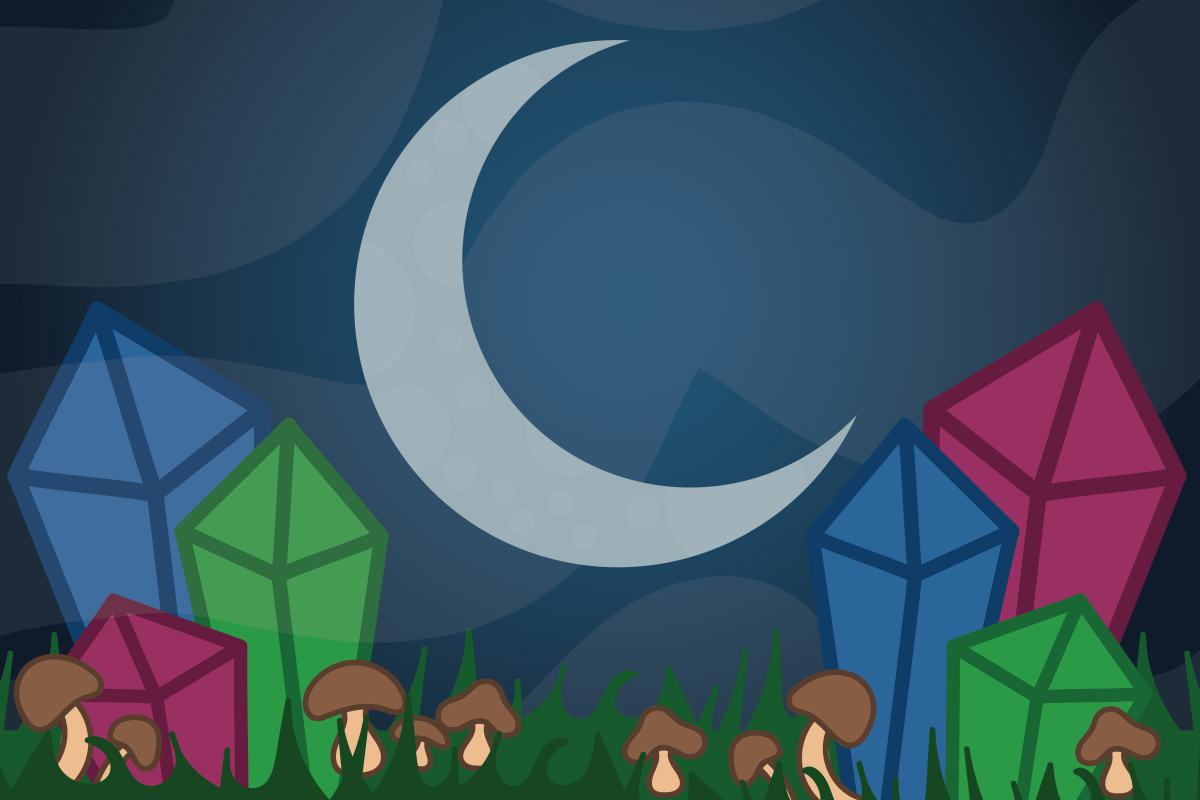The rise of New Age Spiritualism in aesthetic culture has brought along many faddish belief systems across America and different communities. In our globalized society it can be difficult for newer generations to seek out religion, and harder for them to devoutly follow their parents’ practices. With so many groups preaching they have it all figured out, many people find themselves caught in vague agnostic belief just to avoid the headache of figuring out who’s telling the truth. The lure of spiritualism lies in its non-discrimination and varying acceptable practices.
Many people turn to spiritualism for different reasons — some look for holistic healing methods, others protection, while some find their interest piqued by the self-care aspects of spiritual practices. Different practitioners give different answers depending on their needs. Some people like believing in something partially rooted in science that still draws on the spiritual and abstract realm.
Queer people, for example, often associate themselves with witchcraft, which makes sense for a group historically in search of social acceptance and a spiritual place of belonging. Many queer people turn to spiritualistic practices because they focus on the divine energy of the individual and denote the effectiveness of relying on a higher power for personal validation and success.
While you don’t need to call yourself a witch to engage in spiritual practices, manifesting intentions is similar across many spiritual forms. Traditionally, spiritualism requests and allows the universe to align in your favor and open a doorway for you. Some cultures would call this prayer. Whatever you call it, the idea is the same — calling upon a higher power to channel that energy to make our desires come true. One can use crystals as a conduit for natural energy.
Many different crystals and gemstones have varying properties and symbolic uses. However, they are generally used for manifesting themes of protection, provision or healing. A lot of different cultures use crystals to hold or ward off energy. Witches, Buddhists, Native Americans and Middle Eastern cultures all have their own totems, wearable conduits or symbols of a higher power. In a modern spiritualist’s home, you might find crystals intentionally placed in areas that benefit their ritual practice. You can place them in entryways, along window sills and above doorways for protection or in bowls of money and rice to promote abundance. In some cases, you can also use them for channeling and storing moon power.
The full moon craze is a time-old tradition. While modernly associated with Wiccan practices, many different cultures and civilizations revere the moon as a powerful deity or source of power. The moon is the nighttime sun. The moon is a celestial phenomenon for our human experience, as it has historically played a spiritual role as a guiding and protective energy and force. Many cultures believe the moon’s power can heighten the power behind magical spells or spiritual rituals.
Many people believe a full moon is a great time to imbue personal items with moon magic, or lunar energy. They set their crystals, tarot cards, containers of water and other important items out in the full moonlight to “charge.” This process is similar to a priest blessing holy water, but in this case, nature gives her own blessing. Stones, crystals and other natural materials are popular energy conduits of intention setting as well. So, if someone invites you to a full moon party, consider saying yes.
But where does one find all these crystals, guidebooks and spiritual materials? Metaphysical shops are a great place to start and you can find one such shop in Austin tucked away on a residential road off 53rd Street. The black wooden floors and winding rooms covered in books, plants, crystals and other metaphysical products welcome you when walking into Yarrow and Sage. Here, shoppers can find an array of locally sourced fresh and dried herbs, candles, incense, crystals, artwork, metaphysical and magic books, and even more for their varying spiritualistic needs.
Ashley Hammonds, who works at Yarrow and Sage and tables at the monthly Witches Markets, spoke with me about magic and the real-world applications of intention setting. Magic comes from the belief that certain connections between people, places, things and nature hold energy. Hammonds quoted English occultist Aleister Crowley, who said, “Magic is ‘brain change willed.’” Looking for the little joys throughout the day serves as an important practice for a witch, or anyone manifesting intentions. Hammonds explained to me that the intentions and meanings we put behind our objects and actions imbue them with magic.
I told her about how my grandma and her best friend used to have a button-making business, and they left me a giant jar of ceramic buttons of all different shapes and sizes. I intend to use the ceramic buttons as replacements for the buttons on all of my work pants so I can carry a little bit of my grandma with me each day. The difference between a ceramic button and a button with that “good grandma energy” is putting belief into its effectiveness, making you joyful and connected with memories.
For herself, Hammonds pointed to a lone buttercup growing outside the shop in a little pocket of grass in the pavement.
“Every time I see one of these, I think of my grandpa and how he used to come up to me when I was little and stick a buttercup in my nose,” Hammonds said. “You get all sniffly and your nose itches, but it would make me laugh.”
Because of this memory and positive feelings attached to the symbol of a buttercup, they are now a symbol of power for Hammonds that connect her to her grandfather’s energy. Magic is about your individual human experience and the desires you put out into the universe, just as much as it is about your interaction and connection with the world around you.
There are a lot of different ways to cope with modern agnostic belief or “optimistic atheism” as 20-something college students, but the spiritualism route is one that we could all benefit from. At its most basic level, spiritualism acknowledges the abstract human experience. We label that experience as “spiritual” or sometimes “supernatural,” but it has foundational ties with nature. Spiritualism benefits your mind, body and soul because it requires you to place hope in a power that you can feel and see.
“In nature, nothing remains constant,” scientist David Bohm wrote in his book, “Wholeness and the Implicate Order.” “Everything is in a perpetual state of transformation, motion and change.”
Spiritualism, at its core, asks the individual to participate in this process. If we opened our minds and spirits to transformation, motion, and change, we could all benefit in different ways.
































